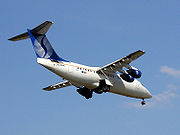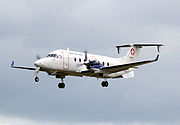
T-tail
Encyclopedia




Empennage
The empennage , also known as the tail or tail assembly, of most aircraft gives stability to the aircraft, in a similar way to the feathers on an arrow...
stabilizer configuration
Configuration
The term configuration has several meanings.In computing it may refer to:* Computer configuration or system configuration* Configure is the output of Autotools and used to detect system configuration...
in which the horizontal surfaces (tailplane
Tailplane
A tailplane, also known as horizontal stabilizer , is a small lifting surface located on the tail behind the main lifting surfaces of a fixed-wing aircraft as well as other non-fixed wing aircraft such as helicopters and gyroplanes...
and elevator
Elevator (aircraft)
Elevators are flight control surfaces, usually at the rear of an aircraft, which control the aircraft's orientation by changing the pitch of the aircraft, and so also the angle of attack of the wing. In simplified terms, they make the aircraft nose-up or nose-down...
s) are mounted to the top of the vertical stabilizer
Vertical stabilizer
The vertical stabilizers, vertical stabilisers, or fins, of aircraft, missiles or bombs are typically found on the aft end of the fuselage or body, and are intended to reduce aerodynamic side slip. It is analogical to a skeg on boats and ships.On aircraft, vertical stabilizers generally point upwards...
. Traditionally, the horizontal control surfaces are mounted to the fuselage
Fuselage
The fuselage is an aircraft's main body section that holds crew and passengers or cargo. In single-engine aircraft it will usually contain an engine, although in some amphibious aircraft the single engine is mounted on a pylon attached to the fuselage which in turn is used as a floating hull...
at the base of the vertical stabilizer. The resulting arrangement looks like the capital letter T when viewed from the front or back, hence the name.
Benefits
The tailplane surfaces are kept well out of the airflow behind the wingWing
A wing is an appendage with a surface that produces lift for flight or propulsion through the atmosphere, or through another gaseous or liquid fluid...
, giving smoother flow, more predictable design characteristics, and better pitch control. This is especially important for planes operating at low speed, where clean airflow is required for control. deHavilland Canada
De Havilland Canada
The de Havilland Aircraft of Canada Ltd. company was an aircraft manufacturer with facilities based in what is now the Downsview area of Toronto, Ontario, Canada...
's line of larger STOL
STOL
STOL is an acronym for short take-off and landing, a term used to describe aircraft with very short runway requirements.-Definitions:There is no one accepted definition of STOL and many different definitions have been used by different authorities and nations at various times and for a myriad of...
aircraft all use this arrangement for this reason. T-tail configuration also allows high performance aerodynamics and excellent glide ratio as the empennage is not affected by wing slipstream. Therefore the T-tail configuration is especially popular on glider
Glider (sailplane)
A glider or sailplane is a type of glider aircraft used in the sport of gliding. Some gliders, known as motor gliders are used for gliding and soaring as well, but have engines which can, in some cases, be used for take-off or for extending a flight...
s.
The tail surfaces are mounted well out of the way of the rear fuselage, permitting this site to be used for the aircraft's engines. This is why the T-tail arrangement is also commonly found on airliner
Airliner
An airliner is a large fixed-wing aircraft for transporting passengers and cargo. Such aircraft are operated by airlines. Although the definition of an airliner can vary from country to country, an airliner is typically defined as an aircraft intended for carrying multiple passengers in commercial...
s with rear-mounted engines, including trijet
Trijet
A Trijet is an aircraft powered by three jet engines. Early twin-jet designs were limited by the FAA's "60-minute rule", whereby the flight path of twin-engined jetliners was restricted to within 60 minutes' flying time from a suitable airport, in case of engine failure. In 1964 this rule was...
s. The Douglas DC-9, Bombardier CRJ200
Bombardier CRJ200
The Bombardier CRJ100 and CRJ200 are a family of regional airliner manufactured by Bombardier, and based on the Canadair Challenger business jet.-Development:...
, Embraer ERJ 145, Boeing 717
Boeing 717
The Boeing 717 is a twin-engine, single-aisle jet airliner, developed for the 100-seat market. The airliner was designed and marketed by McDonnell Douglas as the MD-95, a third-generation derivative of the DC-9. Capable of seating of up to 117 passengers, the 717 has maximum range of...
, Boeing 727
Boeing 727
The Boeing 727 is a mid-size, narrow-body, three-engine, T-tailed commercial jet airliner, manufactured by Boeing. The Boeing 727 first flew in 1963, and for over a decade more were built per year than any other jet airliner. When production ended in 1984 a total of 1,832 aircraft had been produced...
, Fokker 100, Vickers VC-10, Hawker Siddeley Trident
Hawker Siddeley Trident
The Hawker Siddeley HS 121 Trident was a British short/medium-range three-engined jet airliner designed by de Havilland and built by Hawker Siddeley in the 1960s and 1970s...
, BAC 1-11, Tu-134, Tu-154, Il-62, and McDonnell Douglas MD-80, McDonnell Douglas MD-90
McDonnell Douglas MD-90
The McDonnell Douglas MD-90 is a twin-engine, short- to medium-range, single-aisle commercial jet aircraft. The MD-90 was developed from the MD-80 series. Differences from the MD-80 include more fuel efficient International Aero Engines V2500 engines and a longer fuselage...
, all used the T-tail for this reason.
Drawbacks
The aircraft will tend to be much more prone to a dangerous deep stall condition, where blanking of the airflow over the tailplane and elevators by a stalled wing can lead to total loss of pitch control. The F-101 VoodooF-101 Voodoo
The McDonnell F-101 Voodoo was a supersonic military jet fighter which served the United States Air Force and the Royal Canadian Air Force...
suffered from this throughout its service life.
The vertical stabilizer must be made considerably stronger and stiffer to support the force
Force
In physics, a force is any influence that causes an object to undergo a change in speed, a change in direction, or a change in shape. In other words, a force is that which can cause an object with mass to change its velocity , i.e., to accelerate, or which can cause a flexible object to deform...
s generated by the tailplane. Unless expensive composite materials are used, this inevitably makes it heavier as well.
The T-tail configuration can cause several maintenance concerns as well. The control runs to the elevators are more complex and elevator surfaces are much more difficult to casually inspect from the ground. The loss of Alaska Airlines Flight 261
Alaska Airlines Flight 261
Alaska Airlines Flight 261, a McDonnell Douglas MD-83 aircraft, experienced a fatal accident on January 31, 2000 at the Pacific Ocean about 2.7 miles north of Anacapa Island, California. The two pilots, three cabin crewmembers, and 83 passengers on board were killed and the aircraft was destroyed...
was directly attributed to lax maintenance due to the complexity of the T-tail.
Because of concerns about being able to clear the tail, the first high-speed aircraft with a T-tail, the Lockheed F-104 Starfighter
F-104 Starfighter
The Lockheed F-104 Starfighter is a single-engine, high-performance, supersonic interceptor aircraft originally developed for the United States Air Force by Lockheed. One of the Century Series of aircraft, it served with the USAF from 1958 until 1969, and continued with Air National Guard units...
, was at first fitted with a downward-firing ejector seat
Ejector seat
In aircraft, an ejection seat is a system designed to rescue the pilot or other crew of an aircraft in an emergency. In most designs, the seat is propelled out of the aircraft by an explosive charge or rocket motor, carrying the pilot with it. The concept of an eject-able escape capsule has also...
. For later models of this aircraft, capabilities of ejection seats improved, so it was changed to an upward-firing one, to overcome problems in low-altitude escapes.
Due to a lack of airflow over the elevator from a forward mounted engine (piston or turboprop), low speed control is reduced and low speed operation is more difficult for aircraft not designed for low speed operation.
A compromise is also possible, with the tailplane mounted part way up the fin rather than right at the top. The Sud Aviation Caravelle
Sud Aviation Caravelle
The Sud Aviation SE 210 Caravelle was the first short/medium-range jet airliner produced by the French Sud Aviation firm starting in 1955 . The Caravelle was one of the more successful European first generation jetliners, selling throughout Europe and even penetrating the United States market, with...
is an aircraft with this configuration (see cruciform tail
Cruciform tail
The cruciform tail is an aircraft empennage configuration which, when viewed from the aircraft's front or rear, looks much like a cross. The usual arrangement is to have the horizontal stabilizer intersect the vertical tail somewhere near the middle, and above the top of the fuselage.Often this...
).

